This post may contain affiliate links which may generate a small commission from clicks that result in a purchase.
The soil is an extremely complex, variable, and living medium, which is made from: organic matter, minerals, water, air, and living organisms. Olive trees soil performs many vital functions helping them to grow:
- food production
- storage
- filtration
- transportation of many materials, including water, carbon, and nitrogen
If an olive tree grower maintains a good soil structure it has a positive effect on the tree’s root growth, water, and oxygen accessibility, and soil strength (source). Olive tree growers can improve soil structure and influence both chemical and physical natural soil properties by using the following activities: tillage (i.e. preparation of land for growing olives), fertilization, waste disposal, and industrial pollution (source).
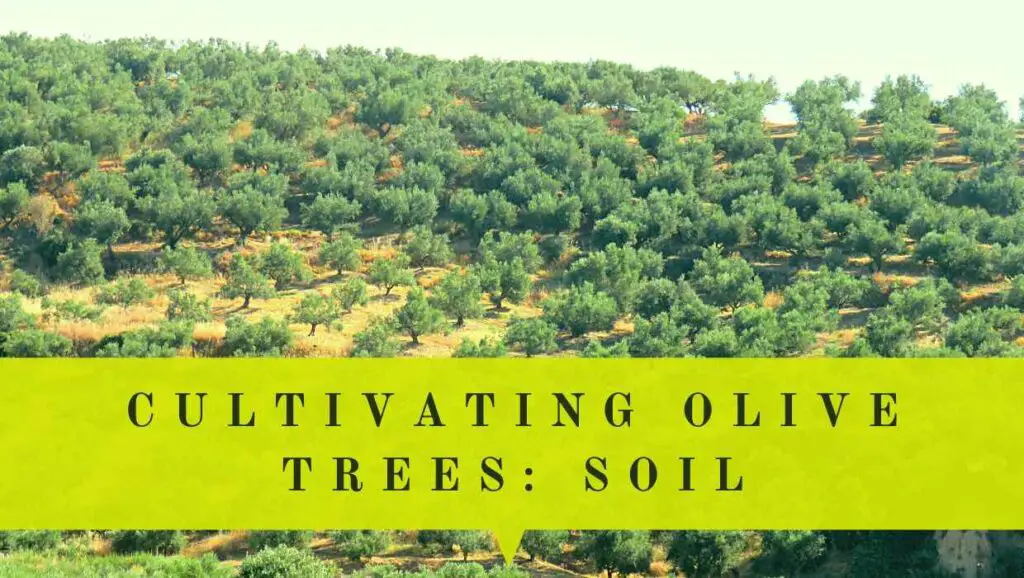
The soil characteristics for an olive plantation are very important in terms of vulnerability to erosion and leaking of contaminating elements found in fertilizers and pesticides. The root system of the olive tree is concentrated in the top 20 – 24 inches (50 – 70 cm) of soil although it may grow roots to a depth of more than 40 inches (1 meter) to satisfy its water needs. Therefore, the soil for olive trees must have an optimal texture, structure, and composition to a depth of at least 40 inches (1 meter).
For this reason, the management of olive tree orchards requires systematic soil testing to assess the existence of any nutritional deficiency, excess, or imbalance. Based on soil testing, olive tree growers can plan nutrient supply via fertilization as well as other practices such as tillage, amendment, and correction.
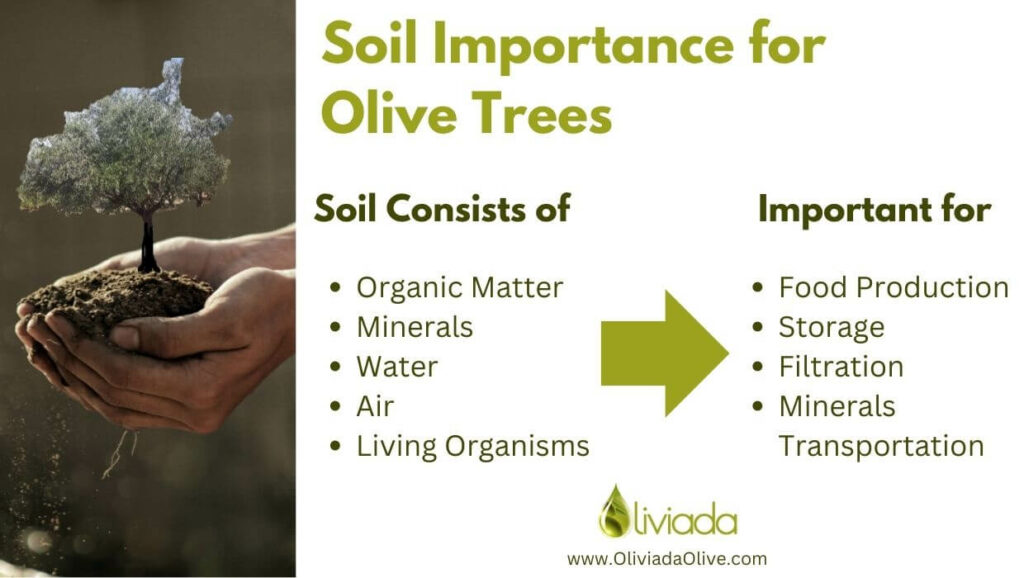
In this olive tree cultivation part, let’s briefly describe the main chemical and physical soil properties.
1.1. Soil texture and structure
It is scientifically proven, that olive trees respond best to soil textures with balanced proportions of sand, silt, and clay. These are three major soil compounds different in their characteristics and respective particle diameter size.
| Soil Compound | Benefits | Negatives |
|---|---|---|
| Clay | Hold onto nutrients, so the olive tree has the food it needs High plasticity | Low permeability of water (holds on water, slow to dry) Root suffocation in wet conditions Notable tenacity and cohesion in the dry state Often alkaline |
| Silt | Hold onto nutrients better than sandy soils Better water holding capacity than sandy soils Easier to work with than clay soils | Low aeration, low permeability, and water stagnation Mud formation in wet conditions greater tendency to pulverization in the dry state |
| Sand | Good aeration and high permeability of rainwater Fast mineralization of organic matter | Nutrients and water often leech away, especially with rainfall It dries out quickly in summer Often acidic |
Too sandy soils do not hold nutrients or water very well needed for olive trees. However, sandy soils do provide good aeration for olive trees, especially during rainwater and during fertilization, to satisfy their mineral requirements.
The soil for olive trees should not contain too much clay to avoid limiting air circulation and prevent soil management problems. However, clay soils have many nutrients but poor drainage which is a must to have for olive trees.
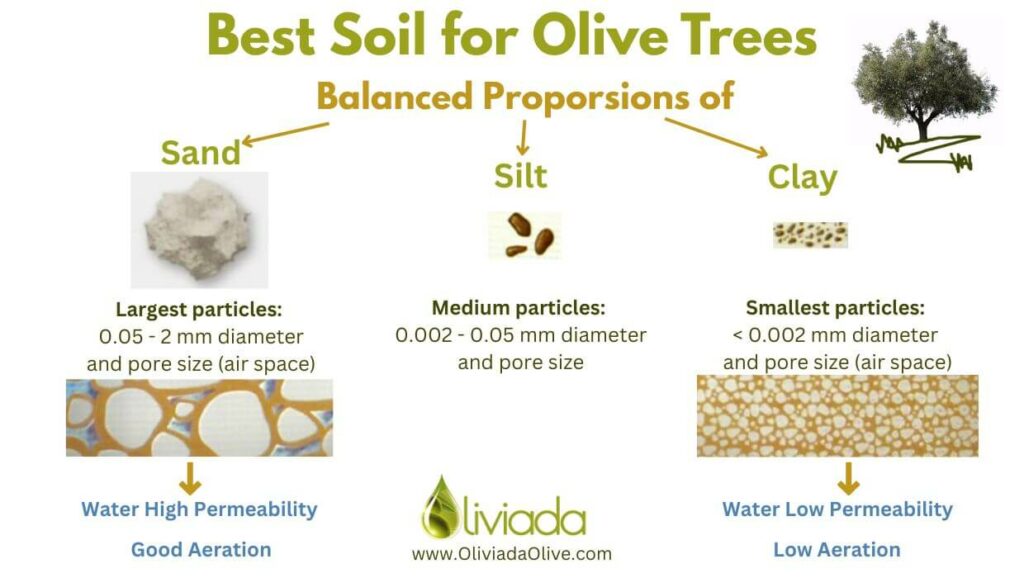
The soil particles should aggregate in granules or bits to make the soil porous for olive trees. This can happen when it is a sufficient amount of organic matter and rational olive soil management to prevent compacting and erosion.
Soil is composed of solid particles (mineral and organic matter) of different sizes, usually bound together into groups by organic matter, mineral oxides, and clay particles. Different organic matter content, texture and structure, and cultivation techniques have a significant effect on soil density and porosity: any management practice that increases organic matter will improve the granular structure of the soil, increase the pore space, and decrease the soil density (source).
Not sure what type of soil is for olive trees you have?
There are two ways to identify the soil. The first one is to do with the soil test, and you send soil samples to the nearest accredited laboratory for particle analysis. Second is the DIY method through the hand texturing process.
1.1.1. Soil Structure Amendments
In terms of soil amendments, olive tree orchards with clay soils may not need to add olive tree fertilizer, but they can add compost and product rich in soil microbes to improve organic matter and drainage.
On the other hand, digging in organic matter and adding a 7 to 10 cm (or 3 to 4 inches) layer of mulch (e.g. straw or compost) over the surface of the soil will help overly sandy soils retain moisture.
In all cases, try to improve organic matter for olive trees by incorporating compost, materials rich in soil microbes, and carbon-rich sources of fertilizers.
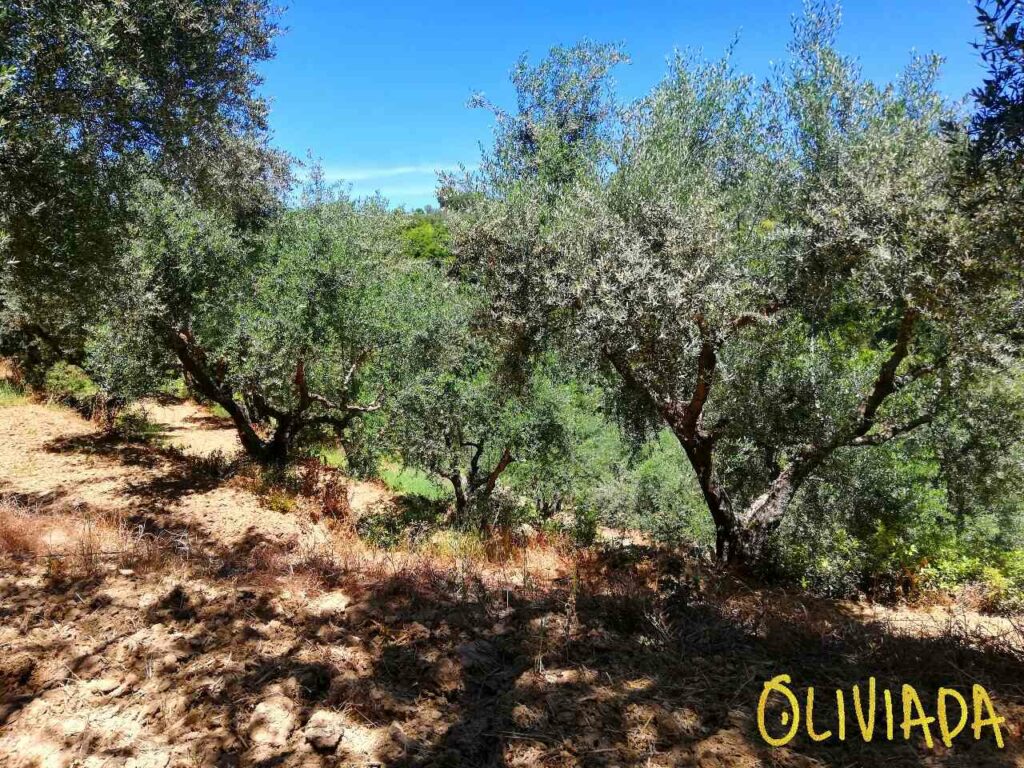
Overall, clay soils may be one of the most challenging to manage, but with the proper techniques can be improved and more favorable for your olive trees. It’s essential to bypass working on the soil when it is wet to reduce the risk of soil compaction. Furthermore, consider using a cover olive during a cool season.
Furthermore, read more about how to prepare the soil when planting olive trees.
1.2. Organic Matter
Organic Matter (OM) is a complex combination of organic compounds deriving from living organism (metabolic) wastes and decaying residuals of plants, animals, and microorganisms at different stages of decomposition.
The OM directly impacts the structure and chemical-physic characteristics of soil in terms of water infiltration and retention, element absorption, particle aggregations, and buffering power over the nutrient source for the olive tree. The quantity and nature of OM are highly affected by farming practices and climatic conditions.
A very important part of good soil management is to increase the organic content, especially to reduce vulnerability to erosion. Olive tree growers can improve it by incorporating organic matter such as farm-yard manure, cover crops, pruning and processing residues, and soil tillage.
Organic carbon and total nitrogen depend on organic matter in the soil. Organic carbon is the primary energy source for soil microbes, but these also require nitrogen to multiply and consume this energy.
1.3. Water Content
Water content analysis is essential for olive trees since it is more difficult to absorb nutrients at low soil moisture levels, as nutrient contents will be lower.
So soil water analyses for olive trees can be organized into two main groups: analysis of storage properties and analysis of hydraulic properties.
The analysis of storage properties refers to the soil’s ability to absorb and hold the water needed for olive trees. Instead, analysis of hydraulic property refers to the soil’s ability to transmit or conduct water.
1.4. Soil pH
Soil pH is one of the most common and important measurements in standard soil analyses for olive trees. The ideal soil pH for olive trees is neutral around 7 pH well-draining soil.
Soil pH is important because it impacts the chemical and physiological processes in the soil and the availability of nutrients. Availability changes differently with pH levels: aluminum, copper, iron, manganese, and zinc increase when the pH decreases, unlike magnesium which decreases when the pH decreases (source).
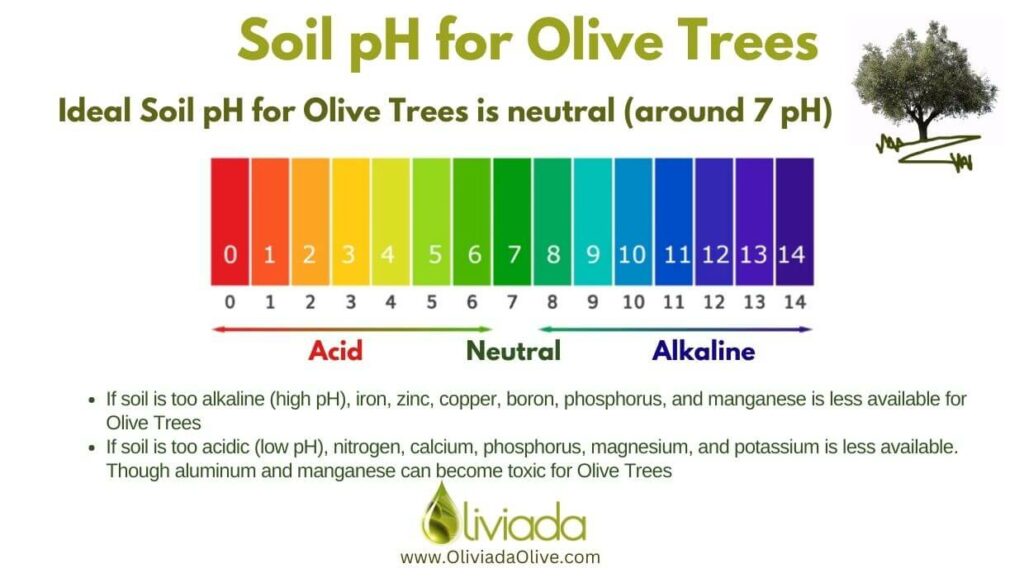
1.4.1. Soil pH Amendments
Soils with low pH (< ~ 5.6), i.e., acid soils, may contain significant amounts of soluble aluminum, which is toxic to the roots of olive trees and other plants. If soil tests reveal too acidic soil, adding some lime (commonly with ground limestone (calcium carbonate)) can be neutralized and make it more suitable for olive trees.
Alternatively, use sulfur that lowers the soil pH if it is not acidic enough.
Consider that different soil additives come in different concentrations, so carefully follow manufacturer instructions to adjust the soil to a specific pH level suitable for olive trees.
1.5. Soil Testing
If you want to learn more about the soil for your olive trees, the best way is to take a soil sample and send it to a local laboratory or nursery for testing. These organizations can make recommendations based on local knowledge of olive trees’ soil as to whether the soil needs pH adjustments or additional nutrients.
On the other hand, if you want to test soil pH, use simple pH testing strips available online and at many gardening centers.
Read Next
Cultivating Olive Trees: Soil Management – Part 2
Cultivating Olive Trees: Nutrition – Part 3
Cultivating Olive Trees: Irrigation – Part 4
Hi, I’m Vangelis Kleftogiannis, the founder of Oliviada and an established olive oil expert from Kalamata, Greece. My expertise isn’t just in producing quality Extra Virgin Olive Oil, but also in the cultivation and care of olive trees themselves. I am deeply committed to sharing my knowledge and know-how, helping others understand the intricacies of olive tree growing and the creation of quality olive oil.
Are You Looking to Buy an Olive Tree?
If you are looking to add more potted trees or other plants to your orchard, or if you like to replace a neglected olive tree, the best places to get them are your local nursery or an online nursery.
One of the most reliable and the world's largest online nurseries is Fast Growing Trees. They deliver fast, neat, and healthy plants backed with a 30-day guarantee.
